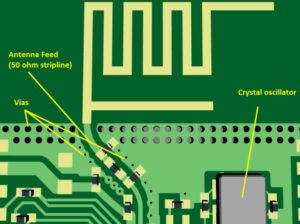 Hi friends welcome to new post. In this post we will learn RF PCB Layout Overview. This is a standard guide to the printed circuit board (PCB) design rules for a high frequency or radio (RF) circuit. Following these rules will help you avoid some of the most common pitfalls in RF construction. Poor PCB structure is one of the most common causes of insufficient transmission or acquisition of EMC performance and failure due to false emissions.
Hi friends welcome to new post. In this post we will learn RF PCB Layout Overview. This is a standard guide to the printed circuit board (PCB) design rules for a high frequency or radio (RF) circuit. Following these rules will help you avoid some of the most common pitfalls in RF construction. Poor PCB structure is one of the most common causes of insufficient transmission or acquisition of EMC performance and failure due to false emissions.
Ideally the engineer who designs the PCB should be familiar with the IPC standards as this provides a rich source of information and the best practice for the standard principles of PCB construction. Here i further want to mentioned that for your projects you can get the hybrid 6-layer PCB stackup in your advanced PCB quote with PCBWAY,. You just have to choose Advanced since you are requesting a custom stackup. Their team will guide you what specific stackup they recommend for manufacturing. If you make the top dielectric low loss, you should also creates the bottom dielectric low loss for symmetry. If you need Rogers 4350 material for low loss at high-f, PCBWay has an equivalent shengyi S7136 material available. Please see details from here: You will required to ask PCBWay in your quote for what core / prepreg thicknesses of S7136 they carry. In your advanced PCB quote, choose “High Frequency PCBs” and choose under High Frequency PCBs: 3.48-3.5 option. You can see this chosen RO4350 equivalent material. with that in “Additional Options” choose “Custom Stackup”
RF PCB Layout Overview
- When planning to set up an RF PCB, the first place to start is to contact the board of your choice board and get their set of guidelines and production skills.
- This will include the minimum track and gap width, ball sizes and other key parameters. The board manufacturer should also be able to provide you with a standard stack of standard and material data, this will include brass metals, dielectric flexibility, and the size of the spinal and pre-installed layers on multi-layer boards.
- Unless your region is extremely simple I suggest using a 4-level board this ensures a continuous ground flight. When using a board on both sides it is very difficult to ensure that the ground plane does not break. Another advantage of a 4-layer board is that the micro-strip size of 50 or 75 ohm design is controllable.
- Use a small calculator to determine the track width required for the design impedance and ensure that it is between production skills, otherwise you may need to discuss a horizontal stack with the manufacturer and choose an unusual construction.
- Another point I should note is that in my experience trying to keep separate ground nets of different signal areas often causes problems than any profit and is mainly reversed in the days before most boards, a single subway plane is the safest way.
- It is quite acceptable to use FR4 boards up to 2.4GHz unless a high level of performance is required. In some cases it is appropriate to define the board as a controlled impedance to provide consistent RF performance.
- After determining the geometry of the track and boards the next step is to deal with partial placement. Ensure that the RF components are positioned in such a way that all RF tracks can be kept at a high altitude with minimal lengths and directional adjustments.
- Start with low signal levels in antenna or RF input and back to baseband or digital location. Keep digital locations and electrical power away from RF analog circuits and keep all RF components on the other side of the board.
- When your RF tracks cannot be processed in a straight line, use the reduced curve if your CAD system supports them, never using the right angles in the RF signal lines.
- If reduced curvature is not supported by the use of a 45-degree series or arcs, this reduces the impedance imbalance which can increase false loss and output.
- In RF buildings it is common to provide a flood on the upper layer and to “attach” this to the earth plane using multiple via’s. If you intend to do this, make sure that the copper is kept at a safe distance from the RF tracks and its components otherwise the impedance will be reduced and cause more damage than good.
- Spacing with spacing can be separated by 5-10mm with very little benefit to sewing using 5mm proximity.
- Tracks from RF materials should be kept as short as possible and use 2 or 3 per parallel in parallel to reduce impedance.
RF Transmission Lines
- Many of Maxim’s RF objects require controlled impedance transmission lines that will transfer the RF power to (or away) from the IC anchors in the PCB.
- These transmission lines can be made in the outer layer (up or down), or buried in the inner layer. Guidelines for these transfer routes include microstrip discussions, linearization, coplanar waveguide (base), and feature impedance.
- It also describes the curvature of the transmission line and the compensation available, as well as the change of the transmission line layer.
That is all about the RF PCB Layout if you have any further query ask in comments. Thanks for reading have a goo day. See you in next post.






